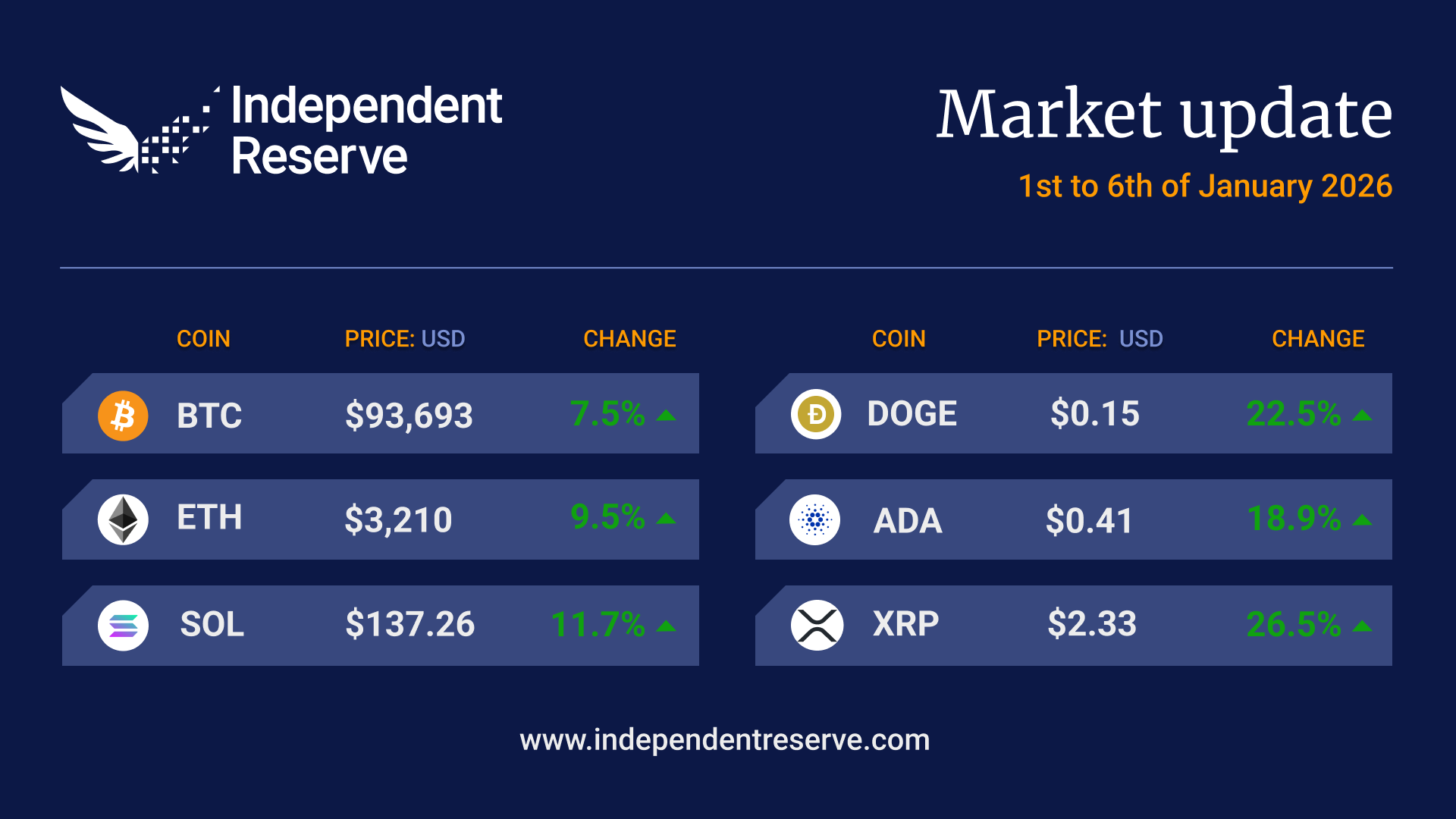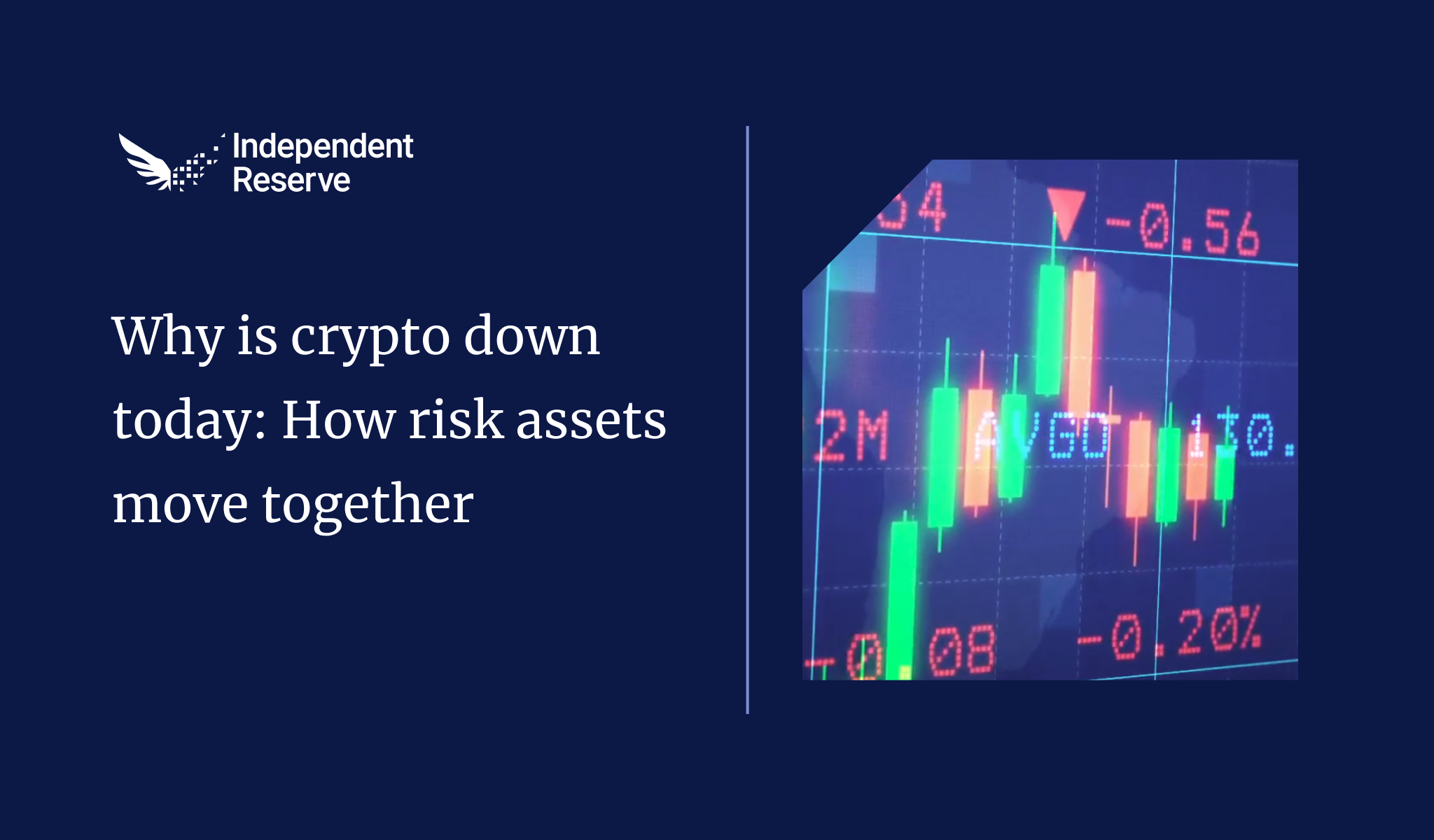In markets
After an uncertain couple of weeks, signs that the traditional finance industry still sees a future for crypto saw Bitcoin recover ground late last week. It finishes up 4% on seven days ago to A$39,400 (US$27,030). Ethereum gained 1% at A$2,546 (US$1,743). Altcoins that the SEC has alleged to be securities continued to slide, with XRP down 5% (after the Hinman emails failed to produce much in its favour), Cardano (+4%) and Polygon (1%). Solana was also up, increasing 7%, and Dogecoin was up 1.6%. The Crypto Fear and Greed Index is stuck at ‘meh’, also known as 47 or Neutral.

From the OTC desk
In general, US equities continue to perform strongly with the Nasdaq now up for the last 8 weeks – this is despite central bank rhetoric remaining hawkish. While market commentary has remained divergent on what is causing the bullish price action, on reflection, AI investment and softening global inflation, appear to be the primary drivers. Quite simply, the US equity market is diverging from the fixed-income market and is forecasting cheaper borrowing costs than current expectations. This risk allocation hasn’t profiled into the cryptocurrency market (just yet) due to undertakings of the US Securities and Exchange Commission (SEC). The BlackRock spot BTC ETF application may be the catalyst for change. For the time being, the correlation between cryptocurrencies and US equities remains broken – at some point, risk assets will again relate.
In the US, the Federal Open Market Committee (FOMC) held the federal funds rate steady (5.00-5.25%) at their June meeting. This was the first FOMC interest rate pause in 10 meetings. The FOMC interest rates projections, however, were increased quite significantly, with the current interest rate projection now at 5.6% (relative to 5.1% prior); the 1yr rate at 4.6% (relative to 4.3% prior); and the 2yr rate at 3.4% (relative to 3.1% prior). The FOMC forecast 1-2 more rate hikes this year – inflation and the labour market will ultimately determine whether any policy change will be required. For the time being, this doesn’t appear obvious, with key inflation markers continuing to soften.
In Australia, the Reserve Bank of Australia Meeting Minutes for June outlined Member reasoning for the additional cash rate increase – to 4.10%.
“The Board affirmed that its priority is to return inflation to target within a reasonable timeframe. The recent data suggested that inflation risks had shifted somewhat to the upside. Given this shift and the already drawn-out return of inflation to target, the Board judged that a further increase in interest rates was warranted.”
Last week the Australian unemployment rate moved back to 3.6% (from 3.7% in May). With +75.9k jobs created in the month and the labour market participation rate increasing from 66.7% to 66.9%, the labour market remains near its strongest level in 50 years. AUD/USD has appreciated from 0.6470 at the beginning of June to currently trade near 0.6800. The catalyst being 1) rising domestic interest rates relative to the US; 2) China stimulus. Last week, the Central Bank of China (BoC) reduced the 1yr Medium Term Lending Facility Rate by 10bps, down to 2.65%. Today, the BoC reduced the 1yr and 5yr Prime Lending rates by 10bps, down to 3.55% and 4.2% respectively. Watch this space.
On the OTC desk, buy-side interest in altcoins has continued. This has eventuated despite last week’s USDT depeg concerns. With the price of the USDT sustaining below peg for a 48-hour period, trading activity in USDT-related pairs has slowed this week. Historically, reduced volumes of USDT would have corresponded with an immediate uptick in USDC flow. For the time being, this hasn’t eventuated – trading activity in USDC (in general) remains reduced due to structural changes in USD banking that began with the fall of Signature and currently remain unsolved. While political and regulatory headwinds remain for the cryptocurrency complex, it is expected that BTC (and ETH) will again profile as a high beta risk asset.
For any further information, please feel free to reach out.
In Headlines
BlackRock likes Bitcoin
The world’s largest asset manager BlackRock, sensationally filed an application for a Bitcoin ETF (a real one, not just a trust) amid the SEC’s crackdown on exchanges and tokens. The A$13.9 trillion (US$9.5T) asset manager has applied for 575 ETFs and only been knocked back on one, giving it a 99.8% success rate. However, the SEC has a 100% success rate at knocking back spot Bitcoin ETFs over the past decade. There is a lot of debate over what the application means: is it BlackRock trying to signal support for crypto, or has it already been given a sneaky nod by the SEC to apply in order to put the “adults” in charge of the sector? Adding to the mystery, BlackRock chose Coinbase – which is currently being sued by the SEC – as a custodian. Whatever is going on, the fact BlackRock is interested in Bitcoin is exactly the shot of confidence the industry needed. A decision could take up to 240 days.
Fidelity rumours
Rumours swirling on Twitter overnight suggest the world’s third largest asset manager Fidelity will put in another spot Bitcoin ETF application, having tried and failed before . Fidelity is also rumoured to be preparing a bid for Grayscale, which is currently fighting the SEC in court over its rejection of an application to turn the Bitcoin Trust (GBTC) into an ETF. Grayscale’s parent company Digital Currency Group is also in financial trouble, so a sale would shore it up. The GBTC discount fell from 44.03% on June 13 to 36.61% on June 16 following the BlackRock news.
Hinman docs are good for ETH, not XRP
The eagerly awaited Hinman documents in the SEC vs Ripple case were finally released… and don’t seem to have been worth all the fuss. They relate to internal SEC documents about a speech by the director of corporation finance William Hinman in which he declared ETH wasn’t a security. Delphi Labs counsel Gabriel Shapiro called them a “nothingburger”, CryptoLaw founder John Deaton doesn’t think they’ll materially affect the outcome of the case, but Hodl Law founder Fred Rispol argues they’ll impact the SEC’s credibility. JPMorgan analysts said the documents were a boost to Ether and would encourage other cryptocurrencies to make themselves as decentralised as possible.
Bitcoin dominance is at 50%, headed to 80%
Earlier today, Bitcoin poked its head above 50% dominance on Trading View for the first time since April 2021. Ethereum is around 20%, giving a 70% market share to the King and Queen of crypto. MicroStrategy boss Michael Saylor predicts Bitcoin is headed for 80% in the long term as regulators crack down on other tokens. “MicroStrategy’s view since 2020 has been that the only institutional-grade investable asset in the crypto space is Bitcoin… The next logical step is for Bitcoin to 10x from here, and then 10x again.”
Bank of America is still onboard the crypto train
The Bank of America remains a true crypto believer, releasing a report stating that regulatory headwinds are “overshadowing the rapid development and integration of distributed ledger and blockchain technology infrastructure. ”The bank says it still expects blockchain infrastructure and tokenisation to “transform financial and non-financing infrastructure and markets over the next five to 10 years.”
Binance.US avoids freeze
Binance.US has avoided having its assets frozen by an SEC application, instead agreeing to a deal that keeps Binance. US operating with its funds kept out of reach of its parent company. Judge Amy Berman Jackson seemed sceptical of the SEC’s regulation by enforcement approach, calling it “inefficient and cumbersome.”
ASX finds 15% of investors hold crypto
A new survey by the Australian Securities Exchange found that crypto is held by 15% of investors overall but by 31% of young investors aged 18-24. Counterintuitively, this group also sees themselves as risk-averse and isn’t fans of volatility. “The apparent financial conservatism of younger investors is at odds with their level of investment in cryptocurrency,” the report says.


